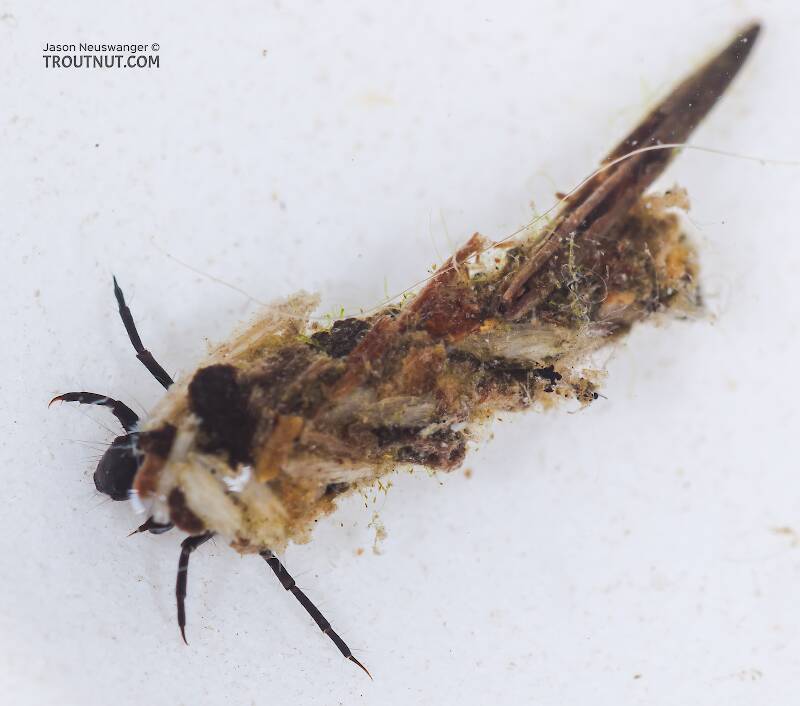
Salmonflies
Pteronarcys californica
The giant Salmonflies of the Western mountains are legendary for their proclivity to elicit consistent dry-fly action and ferocious strikes.
Featured on the forum

This seems to be a young larva of Limnephilus. Although not clear in the picture, several ventral abdominal segments have chloride epithelia.

Troutnut is a project started in 2003 by salmonid ecologist Jason "Troutnut" Neuswanger to help anglers and
fly tyers unabashedly embrace the entomological side of the sport. Learn more about Troutnut or
support the project for an enhanced experience here.
Lastchance on Mar 26, 2013March 26th, 2013, 4:42 pm EDT
Is this pattern meant to be fished in the meniscus? How's that for a word!
Would you say that the caddis spends more time as a deep caddis or an emerging caddis?
Bruce
Would you say that the caddis spends more time as a deep caddis or an emerging caddis?
Bruce
Sayfu
Posts: 560
Posts: 560
Sayfu on Mar 26, 2013March 26th, 2013, 5:12 pm EDT
My response would be that they are deep for a time early on, and best success would be to fish them deep. They even talk about fishing it deep below a strike indicator. Then as the emergence nears fishing shallow, or on the swing from somewhat deeper is effective, and lastly they float for a distance in the meniscus. Seeing adults emerging, or fish surfacing would be the time to fish this way, but it is very difficult to see a caddis coming off the water. Adults are best taken when egg laying, and a dry fished dead drift can become effective when jerked under, as a diving egg layer if the dead drift isn't effective. I like that X caddis as the dry.
Martinlf on Mar 26, 2013March 26th, 2013, 6:21 pm EDT
Bruce, if you're asking about this fly pattern:
http://www.youtube.com/watch?v=1xYFoiTadv0
It's a dry fly, meant to be fished on the surface, or in the meniscus (whatever that is).
http://www.youtube.com/watch?v=1xYFoiTadv0
It's a dry fly, meant to be fished on the surface, or in the meniscus (whatever that is).
"He spread them a yard and a half. 'And every one that got away is this big.'"
--Fred Chappell
--Fred Chappell
Martinlf on Mar 26, 2013March 26th, 2013, 7:28 pm EDT
Thanks, Mack. I was just picking on Bruce, who has, in the past, complained about Latin words and such.
"He spread them a yard and a half. 'And every one that got away is this big.'"
--Fred Chappell
--Fred Chappell
Entoman on Mar 26, 2013March 26th, 2013, 7:56 pm EDT
The meniscus is the tough film at the water's surface caused by surface tension due to interaction with the atmosphere.
Bruce - Most of the important caddis spend much more time deep in the water column drifting along. They spend very little time rising to the surface (though the myth of the super caddis that rises like a missile is probably just that). They also spend a fair amount of time as pharates at the surface. Once the eclosion process starts they free themselves from their exuvia quickly and fly away almost immediately. One would assume from this that half & half style emergers shouldn't be effective, but they are. Perhaps when there's an abundence of cripples? Cutter's E/C Caddis and the similar Iris are two examples.
Prior to the fish showing at the surface, I'll fish pupal patterns deep. My current favorites are the Pettis Glass Bead Pupa, Fox's Poopah (with bead), and the ever-popular Sparkle Pupa (though I tie it with a slightly tighter & sparser shell over the back only). For shallow work imitating the pharates, I like Soft Hackles, Klnkhammers and my Halo Pupa, though the latter is my first choice for really picky feeders..
Edit: Jeez, and I thought you guys were serious!:):)
Bruce - Most of the important caddis spend much more time deep in the water column drifting along. They spend very little time rising to the surface (though the myth of the super caddis that rises like a missile is probably just that). They also spend a fair amount of time as pharates at the surface. Once the eclosion process starts they free themselves from their exuvia quickly and fly away almost immediately. One would assume from this that half & half style emergers shouldn't be effective, but they are. Perhaps when there's an abundence of cripples? Cutter's E/C Caddis and the similar Iris are two examples.
Prior to the fish showing at the surface, I'll fish pupal patterns deep. My current favorites are the Pettis Glass Bead Pupa, Fox's Poopah (with bead), and the ever-popular Sparkle Pupa (though I tie it with a slightly tighter & sparser shell over the back only). For shallow work imitating the pharates, I like Soft Hackles, Klnkhammers and my Halo Pupa, though the latter is my first choice for really picky feeders..
Edit: Jeez, and I thought you guys were serious!:):)
"It's not that I find fishing so important, it's just that I find all other endeavors of Man equally unimportant... And not nearly as much fun!" Robert Traver, Anatomy of a Fisherman
Feathers5
Posts: 287
Posts: 287
Feathers5 on Mar 27, 2013March 27th, 2013, 6:11 am EDT
Gees, I finally use a good word and you guys pick on me.
Crepuscular on Mar 27, 2013March 27th, 2013, 6:28 am EDT
though the myth of the super caddis that rises like a missile is probably just that
I don't know Kurt, I have seen Hydropsychids that seem to do just that on several occasions. But maybe they were drifting prior to swimming to the surface but these definitely swam to the surface very quickly and seemed to have no trouble escaping the pupal shuck and basically went right into the air with a very minimal amount of time in the surface film. Granted when I have witnessed this I was in shallow water, it was dark and I was using a flashlight to watch it all go down, and maybe I wasn't getting the whole picture. And so I may just be perpetuating the myth...
the ever-popular Sparkle Pupa (though I tie it with a slightly tighter & sparser shell over the back only)
I fish that pattern quite a bit as well. and tie it in a what sounds like a similar manner. no big puffy bag around the abdomen, more like its wrapped somewhat tightly in plastic wrap if that makes any sense.
Martinlf on Mar 27, 2013March 27th, 2013, 6:50 am EDT
you guys pick on me
Just me, Bruce.
"He spread them a yard and a half. 'And every one that got away is this big.'"
--Fred Chappell
--Fred Chappell
Entoman on Mar 27, 2013March 27th, 2013, 10:30 am EDT
I don't know Kurt, I have seen Hydropsychids that seem to do just that on several occasions.
It's a matter of degree, Eric. The "myth" referred to is the one that assumed caddis burst from their pupal enclosures and shoot straight to the surface like a rocket with very little if any drift or swimming movement. This erroneous understanding of caddis behavior was quite common when I started out, and went largely unchallenged (at least out West) until LaFontaine. Even hydropsychids usually drift quite a bit before starting their ascent to the surface. Once there they will often drift some more before starting the eclosion process. They generally move very little during these drifting phases, as if stunned. When their hormones kick in, they eclode quickly and usually get up and away very quickly as well. As to the speed of the ascent, being good swimmers they do get to the surface efficiently with a pulsing motion, but nothing like the smooth and ridiculous speed that was assumed.
I remember 'experts' in my youth advising that you couldn't get the fly to swing up fast enough and promoted an exaggerated "Leisenring lift" with a straight downstream drift (no swing). As the fly came to the end of the drift, they recommended lifting the rod as well to further exaggerate the speed. It might work OK in gentle currents if the lift isn't too aggressive, but in the faster currents that hydropsychids seem to prefer, the fly literally ripped to the surface. I also remember it being OK at fooling little fish on occasion.:)
I no longer worry too much about trying to ape their ascension and focus on deep dead drift presentations until the fish start to show.. Then I'll move closer to the surface either with controlled swing or dead drift presentations (the latter especially with brachycentrids). Except for the occasional use of Cutter E/C type patterns, I don't seem to go with dry flies much unless I'm seeing strong evidence of floating adults being taken. It's an odds thing ...
"It's not that I find fishing so important, it's just that I find all other endeavors of Man equally unimportant... And not nearly as much fun!" Robert Traver, Anatomy of a Fisherman
Quick Reply
Related Discussions
Topic
Replies
Last Reply




